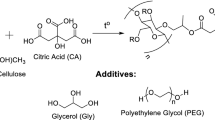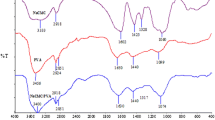Abstract
The Diels-Alder reaction was used to fabricate hydroxypropyl methylcellulose-based hydrogels. First, hydroxypropylmethylcellulose (HPMC) was modified by a carboxyl-containing diene molecule (SFA) which was synthesised from furfurylamine and succinic anhydride. Second, dienophile groups were introduced into HPMC by the coupling reaction with N-maleoyl alanine (AMI) using N,N′-dicyclohexylcarbodiimide (DCC) and 4-dimethylaminopyridine (DMAP). Subsequently, the asprepared furan- and maleimide-modified HPMC were dissolved in water and gelation was observed at a pre-determined temperature after a period of time. The samples thus obtained were characterised by FTIR, NMR, SEM, etc. The gelation time changing with temperature, concentration of the solution, and solvent was measured. It was found that gelation time decreased with increasing temperature and concentration of the solution, and that water had a rate-accelerating effect on Diels-Alder reaction. The swelling behaviour indicates that the hydrogels have a high swelling ratio in water and the swelling ratio increases with the increasing temperature. Taking into consideration that the HPMC-based hydrogels are prepared under mild reaction conditions with an adjustable gelation time and thermal stability, the method described here has a potential application in biomaterials, especially in the areas of tissue-engineering and drug-controlled release carriers.
Similar content being viewed by others
References
Abe, K., & Yano, H. (2012). Cellulose nanofiber-based hydrogels with high mechanical strength. Cellulose, 19, 1907–1912. DOI: 10.1007/s10570-012-9784-3.
Bajpai, A. K., & Giri, A. (2002). Swelling dynamics of a macromolecular hydrophilic network and evaluation of its potential for controlled release of agrochemicals. Reactive & Functional Polymers, 53, 125–141. DOI: 10.1016/s1381-5148(02)00168-2.
Bao, Y., Ma, J., & Sun, Y. (2012). Swelling behaviors of organic/inorganic composites based on various cellulose derivatives and inorganic particles. Carbohydrate Polymers, 88, 589–595. DOI: 10.1016/j.carbpol.2012.01.003.
Burdock, G. A. (2007). Safety assessment of hydroxypropyl methylcellulose as a food ingredient. Food and Chemical Toxicology, 45, 2341–2351. DOI: 10.1016/j.fct.2007.07.011.
Chang, C., & Zhang, L. (2011). Cellulose-based hydrogels: Present status and application prospects. Carbohydrate Polymers, 84, 40–53. DOI: 10.1016/j.carbpol.2010.12.023.
Choi, S. W., Moon, S. K., Chu, J. Y., Lee, H. W., Park, T. J., & Kim, J. H. (2012). Alginate hydrogel embedding poly(d,l-lactide-co-glycolide) porous scaffold disks for cartilage tissue engineering. Macromolecular Research, 20, 447–452. DOI: 10.1007/s13233-012-0130-2.
Dalvi, S. V., & Dave, R. N. (2010). Analysis of nucleation kinetics of poorly water-soluble drugs in presence of ultrasound and hydroxypropyl methyl cellulose during antisolvent precipitation. International Journal of Pharmaceutics, 387, 172–179. DOI: 10.1016/j.ijpharm.2009.12.026.
Das, R., Panda, A. B., & Pal, S. (2012). Synthesis and characterization of a novel polymeric hydrogel based on hydroxypropyl methyl cellulose grafted with polyacrylamide. Cellulose, 19, 933–945. DOI: 10.1007/s10570-012-9692-6.
Diaf, K., El Bahri, Z., Chafi, N., Belarbi, L., & Mesli, A. (2012). Ethylcellulose, polycaprolactone, and eudragit matrices for controlled release of piroxicam from tablets and microspheres. Chemical Papers, 66, 779–786. DOI: 10.2478/s11696-012-0191-x.
Ding, C., Zhang, M., Tian, H., & Li, G. (2013). Effect of hydroxypropyl methylcellulose on collagen fibril formation in vitro. International Journal of Biological Macromolecules, 52, 319–326. DOI: 10.1016/j.ijbiomac.2012.10.003.
Escudero, J. J., Ferrero, C., Casas, M., & Jiménez-Castellanos, M. R. (2012). Compaction properties, drug release kinetics and fronts movement studies of matrices combining mixtures of swellable and inert polymers. III: Effect of polymer substitution type. International Journal of Pharmaceutics, 434, 215–223. DOI: 10.1016/j.ijpharm.2012.05.027.
Fan, L., Tan, C., Wang, L., Pan, X., Cao, M., Wen, F., **e, W., & Nie, M. (2013). Preparation, characterization and the effect of carboxymethylated chitosan-cellulose derivatives hydrogels on wound healing. Journal of Applied Polymer Science, 128, 2789–2796. DOI: 10.1002/app.38456.
Fruk, L., Grondin, A., Smith, W. E., & Graham, D. (2002). A new approach to oligonucleotide labelling using Diels-Alder cycloadditions and detection by SERRS. Chemical Communications, 2002, 2100–2101. DOI: 10.1039/b204790j.
Goodwin, D. J., Picout, D. R., Ross-Murphy, S. B., Holland, S. J., Martini, L. G., & Lawrence, M. J. (2011). Ultrasonic degradation for molecular weight reduction of pharmaceutical cellulose ethers. Carbohydrate Polymers, 83, 843–851. DOI: 10.1016/j.carbpol.2010.08.068.
Granja, P. L., De Jéso, B., Bareille, R., Rouais, F., Baquey, C., & Barbosa, M. A. (2006). Cellulose phosphates as biomaterials. In vitro biocompatibility studies. Reactive & Functional Polymers, 66, 728–739. DOI: 10.1016/j.reactfunctpolym.2005.10.027.
Han, J., Lei, T., & Wu, Q. (2014). High-water-content mouldable polyvinyl alcohol-borax hydrogels reinforced by welldispersed cellulose nanoparticles: Dynamic rheological properties and hydrogel formation mechanism. Carbohydrate Polymers, 102, 306–316. DOI: 10.1016/j.carbpol.2013.11.045.
Hao, J., & Weiss, R. A. (2013). Mechanical behavior of hybrid hydrogels composed of a physical and a chemical network. Polymer, 54, 2174–2182. DOI: 10.1016/j.polymer.2013.01.052.
Hardy, I. J., Windberg-Baarup, A., Neri, C., Byway, P. V., Booth, S. W., & Fitzpatrick, S. (2007). Modulation of drug release kinetics from hydroxypropyl methyl cellulose matrix tablets using polyvinyl pyrrolidone. International Journal of Pharmaceutics, 337, 246–253. DOI: 10.1016/j.ijpharm.2007.01.026.
Hill, K. W., Taunton-Rigby, J., Carter, J. D., Kropp, E., Vagle, K., Pieken, W., McGee, D. P. C., Husar, G. M., Leuck, M., Anziano, D. J., & Sebesta, D. P. (2001). Diels-Alder bioconjugation of diene-modified oligonucleotides. The Journal of Organic Chemistry, 66, 5352–5358. DOI: 10.1021/jo0100190.
Hu, X., Hu, K., Zeng, L., Zhao, M., & Huang, H. (2010). Hydrogels prepared from pineapple peel cellulose using ionic liquid and their characterization and primary sodium salicylate release study. Carbohydrate Polymers, 82, 62–68. DOI: 10.1016/j.carbpol.2010.04.023.
Jo, S., Kim, S., & Noh, I. (2012). Synthesis of in situ chondroitin sulfate hydrogel through phosphine-mediated Michael type addition reaction. Macromolecular Research, 20, 968–976. DOI: 10.1007/s13233-012-0138-7.
Karaaslan, M. A., Tshabalala, M. A., Yelle, D. J., & Buschle-Diller, G. (2011). Nanoreinforced biocompatible hydrogels from wood hemicelluloses and cellulose whiskers. Carbohydrate Polymers, 86, 192–201. DOI: 10.1016/j.carbpol.2011.04.030.
Katono, H., Maruyama, A., Sanui, K., Ogata, N., Okano, T., & Sakurai, Y. (1991). Thermo-responsive swelling and drug release switching of interpenetrating polymer networks composed of poly(acrylamide-co-butyl methacrylate) and poly(acrylic acid). Journal of Controlled Release, 16, 215–228. DOI: 10.1016/0168-3659(91)90045-f.
Khan, I. A., Anjum, K., Koya, P. A., & Kabir-ud-Din (2013). Effect of inorganic salts on the clouding behavior of hydroxypropyl methyl cellulose in presence of amphiphilic drugs. Colloids and Surfaces B: Biointerfaces, 103, 496–501. DOI: 10.1016/j.colsurfb.2012.10.028.
Kim, T. D., Luo, J., Tian, Y., Ka, J. W., Tucker, N. M., Haller, M., Kang, J. W., & Jen, A. K. Y. (2006). Diels-Alder “click chemistry” for highly efficient electrooptic polymers. Macromolecules, 39, 1676–1680. DOI: 10.1021/ma052087k.
Kowalczuk, J., Tritt-Goc, J., & Pi’slewski, N. (2004). The swelling properties of hydroxypropyl methyl cellulose loaded with tetracycline hydrochloride: magnetic resonance imaging study. Solid State Nuclear Magnetic Resonance, 25, 35–41. DOI: 10.1016/j.ssnmr.2003.03.016.
Kowalczuk, J., & Tritt-Goc, J. (2011). Effect of microwave irradiation on the hydroxypropyl methylcellulose powder and its hydrogel studied by magnetic resonance imaging. Carbohydrate Polymers, 83, 166–170. DOI: 10.1016/j.carbpol.2010.07.037.
Kuang, J., Yuk, K. Y., & Huh, K. M. (2011). Polysaccharidebased superporous hydrogels with fast swelling and superabsorbent properties. Carbohydrate Polymers, 83, 284–290. DOI: 10.1016/j.carbpol.2010.07.052.
Laity, P. R., & Cameron, R. E. (2010). Synchrotron X-ray microtomographic study of tablet swelling. European Journal of Pharmaceutics and Biopharmaceutics, 75, 263–276. DOI: 10.1016/j.ejpb.2010.02.009.
Laity, P. R., Mantle, M. D., Gladden, L. F., & Cameron, R. E. (2010). Magnetic resonance imaging and X-ray microtomography studies of a gel-forming tablet formulation. European Journal of Pharmaceutics and Biopharmaceutics, 74, 109–119. DOI: 10.1016/j.ejpb.2009.06.014.
Lamberti, G., Cascone, S., Cafaro, M. M, Titomanlio, G., d’Amore, M., & Barba, A. A. (2013). Measurements of water content in hydroxypropyl-methyl-cellulose based hydrogels via texture analysis. Carbohydrate Polymers, 92, 765–768. DOI: 10.1016/j.carbpol.2012.10.003.
Li, Y. M., Xu, G. Y., **n, X., Cao, X. R., & Wu, D. (2008). Dilational surface viscoelasticity of hydroxypropyl methyl cellulose and CnTAB at air-water surface. Carbohydrate Polymers, 72, 211–221. DOI: 10.1016/j.carbpol.2007.08.008.
Li, W., Sun, B., & Wu, P. (2009). Study on hydrogen bonds of carboxymethyl cellulose sodium film with two-dimensional correlation infrared spectroscopy. Carbohydrate Polymers, 78, 454–461. DOI: 10.1016/j.carbpol.2009.05.002.
Liu, S. Q., Joshi, S. C., & Lam, Y. C. (2008). Effects of salts in the Hofmeister series and solvent isotopes on the gelation mechanisms for hydroxypropylmethylcellulose hydrogels. Journal of Applied Polymer Science, 109, 363–372. DOI: 10.1002/app.28079.
Mohamed, R. R., Seoudi, R. S., & Sabaa, M.W. (2012). Synthesis and characterization of antibacterial semi-interpenetrating carboxymethyl chitosan/poly(acrylonitrile) hydrogels. Cellulose, 19, 947–958. DOI: 10.1007/s10570-012-9658-8.
Naik, S., Bhattacharjya, G., Talukdar, B., & Patel, B. K. (2004). Chemoselective acylation of amines in aqueous media. European Journal of Organic Chemistry, 2004, 1254–1260. DOI: 10.1002/ejoc.200300620.
Nimmo, C. M., Owen, S. C., & Shoichet, M. S. (2011). Diels-Alder click cross-linked hyaluronic acid hydrogels for tissue engineering. Biomacromolecules, 12, 824–830. DOI: 10.1021/bm101446k.
Pygall, S. R., Kujawinski, S., Timmins, P., & Melia, C. D. (2009). Mechanisms of drug release in citrate buffered HPMC matrices. International Journal of Pharmaceutics, 370, 110–120. DOI: 10.1016/j.ijpharm.2008.11.022.
Qin, X., Lu, A., & Zhang, L. (2013). Gelation behavior of cellulose in NaOH/urea aqueous system via cross-linking. Cellulose, 20, 1669–1677. DOI: 10.1007/s10570-013-9961-z.
Ramasamy, T., Khandasami, U. S., Ruttala, H., & Shanmugam, S. (2012). Development of solid lipid nanoparticles enriched hydrogels for topical delivery of anti-fungal agent. Macro molecular Research, 20, 682–692. DOI: 10.1007/s13233-012-0107-1.
Sannino, A., Pappad`a, S., Madaghiele, M., Maffezzoli, A., Ambrosio, L., & Nicolais, L. (2005). Crosslinking of cellulose derivatives and hyaluronic acid with water-soluble carbodiimide. Polymer, 46, 11206–11212. DOI: 10.1016/j.polymer.2005.10.048.
Saxena, A., Kaloti, M., & Bohidar, H. B. (2011). Rheological properties of binary and ternary protein-polysaccharide cohydrogels and comparative release kinetics of salbutamol sulphate from their matrices. International Journal of Biological Macromolecules, 48, 263–270. DOI: 10.1016/j.ijbiomac.2010.11.008.
Sun, X. L., Yang, L. C., & Chaikof, E. L. (2008). Chemoselective immobilization of biomolecules through aqueous Diels-Alder and PEG chemistry. Tetrahedron Letters, 49, 2510–2513. DOI: 10.1016/j.tetlet.2008.02.111.
Tiwari, S., & Kumar, A. (2006). Diels-Alder reactions are faster in water than in ionic liquids at room temperature. Angewandte Chemie International Edition, 45, 4824–4825. DOI: 10.1002/anie.200600426.
Wang, Z. C., Xu, X. D., Chen, C. S., Wang, G. R., Cheng, S. X., Zhang, X. Z., & Zhuo, R. X. (2009). In situ formation of thermosensitive P(NIPAAm-co-GMA)/PEI hydrogels. Reactive & Functional Polymers, 69, 14–19. DOI: 10.1016/j.reactfunctpolym.2008.10.004.
Wei, H. L., Yang, Z., Chen, Y., Chu, H. J., Zhu, J., & Li, Z. C. (2010a). Characterisation of N-vinyl-2-pyrrolidonebased hydrogels prepared by a Diels-Alder click reaction in water. European Polymer Journal, 46, 1032–1039. DOI: 10.1016/j.eurpolymj.2010.01.025.
Wei, H. L., Yang, Z., Chu, H. J., Zhu, J., Li, Z. C., & Cui, J. S. (2010b). Facile preparation of poly(N-isopropylacrylamide)-based hydrogels via aqueous Diels-Alder click reaction. Polymer, 51, 1694–1702. DOI: 10.1016/j.polymer.2010.02.008.
Wei, H. L., Yang, J., Chu, H. J., Yang, Z., Ma, C. C., & Yao, K. (2011). Diels-Alder reaction in water for the straightforward preparation of thermoresponsive hydrogels. Journal of Applied Polymer Science, 120, 974–980. DOI: 10.1002/app.33116.
Wu, J., Liang, S., Dai, H., Zhang, X., Yu, X., Cai, Y., Zhang, L., Wen, N., Jiang, B., & Xu, J. (2010). Structure and properties of cellulose/chitin blended hydrogel membranes fabricated via a solution pre-gelation technique. Carbohydrate Polymers, 79, 677–684. DOI: 10.1016/j.carbpol.2009.09.022.
Xu, X. D., Chen, C. S., Lu, B., Wang, Z. C., Cheng, S. X., Zhang, X. Z., & Zhuo, R. X. (2009). Modular synthesis of thermosensitive P(NIPAAm-co-HEMA)/β-CD based hydrogels via click chemistry. Macromolecular Rapid Communications, 30, 157–164. DOI: 10.1002/marc.200800671.
YerriSwamy, B., Prasad, C. V., Reedy, C. L. N., Mallikarjuna, B., Rao, K. C., & Subha, M. C. S. (2011). Interpenetrating polymer network microspheres of hydroxypropyl methyl cellulose/poly (vinyl alcohol) for control release of ciprofloxacin hydrochloride. Cellulose, 18, 349–357. DOI: 10.1007/s10570-010-9475-x.
Yu, H. Q., & Cong, R. (2010). Preparation and characterization of hydrogels based on acryloyl end-capped four-arm star-shaped poly(ethylene glycol)-branched-oligo(l-lactide) via Michael-type addition reaction. Chemical Papers, 64, 619–624. DOI: 10.2478/s11696-010-0055-1.
Yue, Z., Wen, F., Gao, S., Ang, M. Y., Pallathadka, P. K., Liu, L., & Yu, H. (2010). Preparation of three-dimensional interconnected macroporous cellulosic hydrogels for soft tissue engineering. Biomaterials, 31, 8141–8152. DOI: 10.1016/j.biomaterials.2010.07.059.
Zhao, G. H., Kapur, N., Carlin, B., Selinger, E., & Guthrie, J. T. (2011). Characterisation of the interactive properties of microcrystalline cellulose-carboxymethyl cellulose hydrogels. International Journal of Pharmaceutics, 415, 95–101. DOI: 10.1016/j.ijpharm.2011.05.054.
Author information
Authors and Affiliations
Corresponding author
Electronic supplementary material
Rights and permissions
About this article
Cite this article
Wang, GF., Chu, HJ., Wei, HL. et al. Click synthesis by Diels-Alder reaction and characterisation of hydroxypropyl methylcellulose-based hydrogels. Chem. Pap. 68, 1390–1399 (2014). https://doi.org/10.2478/s11696-014-0574-2
Received:
Revised:
Accepted:
Published:
Issue Date:
DOI: https://doi.org/10.2478/s11696-014-0574-2




